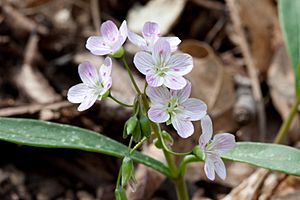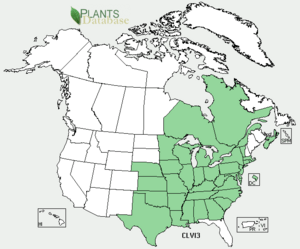Virginia springbeauty facts for kids
Quick facts for kids Virginia springbeauty |
|
|---|---|
 |
|
| Eastern spring beauty at Radnor Lake | |
| Conservation status | |
| Scientific classification | |
| Genus: |
Claytonia
|
| Species: |
virginica
|
 |
|
| Natural range in North America | |
The Virginia springbeauty, also known as eastern spring beauty or fairy spud, is a lovely plant called Claytonia virginica. It's an herbaceous perennial, which means it's a plant with soft stems that lives for more than two years. It belongs to the Montiaceae family. You can find this plant growing naturally in eastern North America. Its scientific name was chosen to honor John Clayton, a famous botanist from Colonial Virginia who lived from 1694 to 1773.
Contents
About the Virginia Springbeauty Plant
The springbeauty is a perennial plant. This means it comes back year after year. It survives the winter thanks to a special tuber (a swollen underground stem) that acts like a food storage unit.
What the Plant Looks Like
This plant grows low to the ground, usually reaching about 5 to 40 centimeters (2 to 16 inches) tall. Its leaves are long and narrow, shaped like a spear. They are typically 3 to 14 cm (1 to 5.5 inches) long and 0.5 to 2 cm (0.2 to 0.8 inches) wide. Each leaf has a stem-like part called a petiole, which can be 6 to 20 cm (2.4 to 7.9 inches) long.
Springbeauty Flowers and Seeds
The flowers of the springbeauty are small, about 0.7 to 1.4 cm (0.3 to 0.6 inches) across. They usually have five petals that are pale pink or white. Sometimes, you might even see rare yellow ones! These flowers can reflect UV light, which helps attract pollinators.
The flowers grow in a cluster called a raceme. This means they branch off a main stem. Each individual flower blooms for about three days. However, the five stamens (the parts that produce pollen) on each flower are only active for one day. Springbeauty flowers appear between March and May, depending on the location and weather.
The seeds are tiny, about 0.2 to 0.3 cm (0.08 to 0.12 inches) wide, and are shiny black. They are released from a fruit called a capsule when it bursts open. The seeds have special little parts called Elaiosomes. These parts attract ants, which then help spread the seeds around.
The springbeauty is a polyploid plant. This means it has more than two sets of chromosomes in its cells. The number of chromosomes can vary a lot, from 12 to 191! The highest number of chromosomes was found in plants growing in New York City.
Where Springbeauty Plants Live
You can find the springbeauty plant in the Eastern temperate deciduous forests of North America. It's known for growing in large numbers in many places, especially in forests. This plant is quite adaptable and can live in many different environments. You might spot it in lawns, city parks, along roadsides, in wetlands, on bluffs, and in ravines.
Hammond's Yellow Springbeauty
There's a special type of springbeauty called Claytonia virginica var. hammondiae. It's also known as Hammond's yellow spring beauty. This variety is very rare and only grows in a few small areas in Northwestern New Jersey.
How People Use Springbeauty
Native American tribes have used the springbeauty plant for different purposes.
Medicinal Uses
The Iroquois people used this plant as medicine. They would make a cold drink from the powdered roots to help children who were having convulsions. They also ate the raw roots, believing it would prevent pregnancy.
Springbeauty as Food
Both the Iroquois and the Algonquin people ate the roots of the springbeauty plant. They would cook them much like potatoes. The entire plant, including the underground parts (corms) and the parts above ground, is safe for people to eat. You can even cook the leaves in salted water, though they might not be the tastiest part!
See also
 In Spanish: Claytonia virginica para niños
In Spanish: Claytonia virginica para niños


